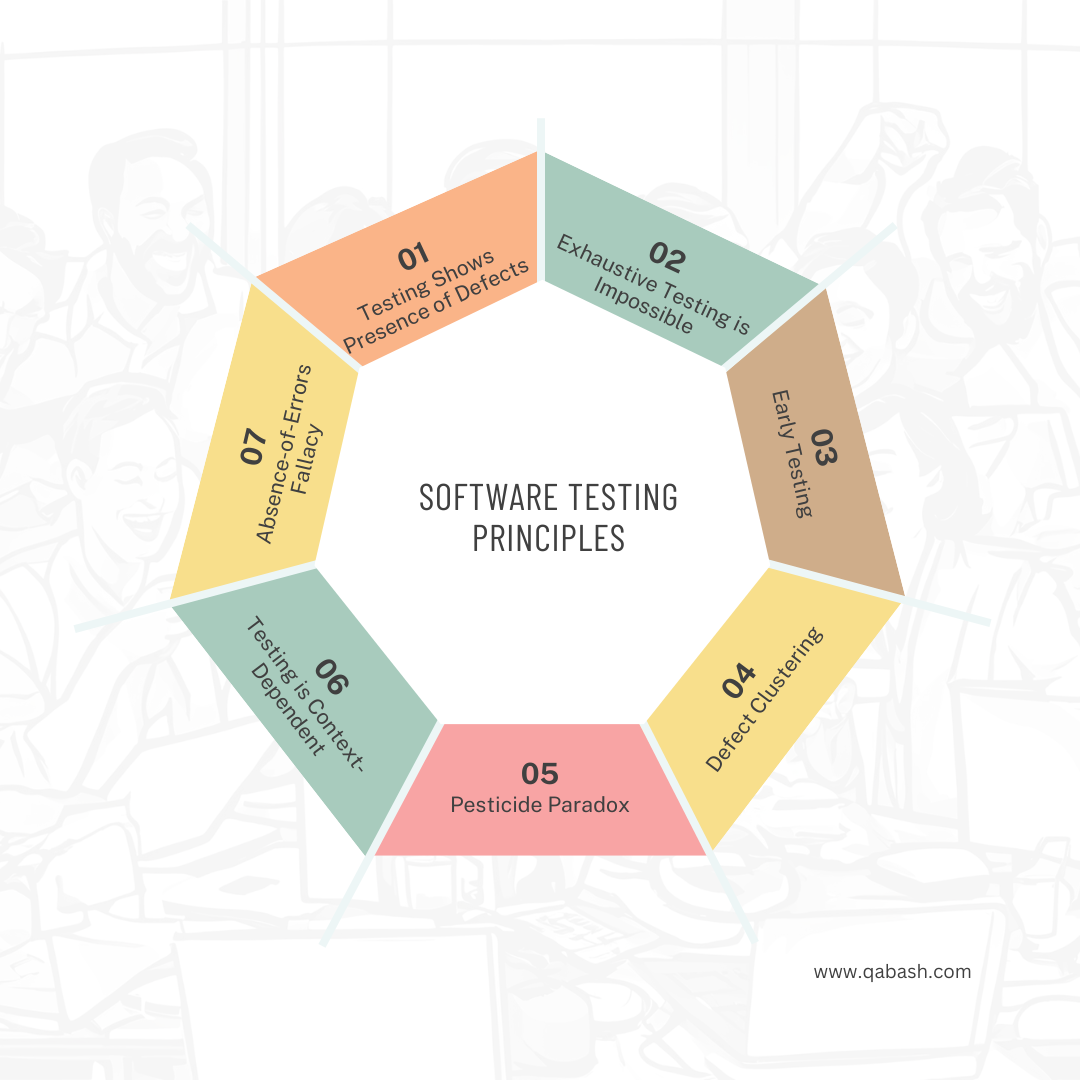
Software testing is an integral part of the software development lifecycle (SDLC). It ensures that the final product meets the required standards and functions correctly. To guide testers in conducting effective and efficient testing, there are seven fundamental principles. Understanding and applying these principles can significantly enhance the quality of the software and the overall development process. Let’s understand each of these principles and see how they apply in real-world scenarios.
Understanding the Basics of Software Testing
What is Software Testing?
Software testing is the process of evaluating and verifying that a software application or system meets specified requirements and is free of defects. It involves executing the software components to identify any errors, gaps, or missing requirements in contrast to the actual requirements.
Importance of Software Testing
The primary goal of software testing is to ensure the delivery of a high-quality product that meets user expectations. It helps in identifying defects early, reducing the cost of fixing bugs, and improving the overall user experience. Effective testing leads to robust, reliable, and user-friendly software applications.
The Seven Principles of Software Testing

1. Principle of Complete Testing
Complete testing of software is not possible due to the vast number of input combinations and execution paths. Instead, testers aim to prioritize and focus on the most critical areas, using risk-based and context-driven testing techniques.
Example: Imagine testing an e-commerce website. It’s impractical to test every possible combination of product searches, user interactions, and payment methods. Instead, testers focus on key functionalities like user registration, product search, checkout, and payment processing.
2. Principle of Defect Clustering
Defects tend to cluster in specific modules or areas of the software. This principle suggests that a small number of modules often contain the majority of defects. By identifying and focusing on these clusters, testers can efficiently uncover more defects.
Example: In a banking application, testers may find that the module handling financial transactions has more defects compared to other modules. By prioritizing testing efforts on this module, they can identify and fix critical issues more effectively.
3. Principle of Pesticide Paradox
Using the same set of test cases repeatedly can eventually make them ineffective. This principle advises testers to regularly review and update test cases to cover new scenarios and detect different types of defects.
Example: Consider testing an email application. Initially, the test cases focus on sending and receiving emails. Over time, as new features like spam filtering and calendar integration are added, the test cases need to be updated to cover these new functionalities.
4. Principle of Testing Shows Presence of Defects
Testing can show that defects are present, but it cannot prove that the software is completely defect-free. This principle highlights the importance of thorough testing to find as many defects as possible but recognizes that some defects may still remain.
Example: In a social media app, even after extensive testing, some bugs might only be discovered when the application is used in a real-world environment with a diverse user base and varying usage patterns.
5. Principle of Absence-of-Errors Fallacy
Even if a software product is free of defects, it may still fail to meet the user’s needs and expectations. This principle emphasizes that testing should not only focus on finding and fixing defects but also ensure that the software fulfills the intended purpose and requirements.
Example: A fitness tracking app might be technically flawless but fail to engage users if it lacks essential features like goal setting, progress tracking, and social sharing capabilities.
6. Principle of Early Testing
Testing should start as early as possible in the software development lifecycle. Early testing helps identify defects at an early stage, reducing the cost and effort required to fix them later in the development process.
Example: In an agile development environment, testers participate in sprint planning sessions and start creating test cases as soon as the requirements are defined. This approach allows them to catch and address issues early, before they become more complex and costly to fix.
7. Principle of Testing is Context Dependent
The testing approach and techniques used should be tailored to the context of the project. Different types of software applications require different testing strategies based on their specific requirements, risks, and constraints.
Example: Testing a healthcare application requires a different approach compared to testing a gaming app. The healthcare app needs rigorous testing for data accuracy, security, and compliance with regulatory standards, while the gaming app focuses on performance, usability, and compatibility across different devices.
Implementing the 7 Software Testing Principles in day to day activities
1. Principle of Complete Testing
Complete testing, also known as exhaustive testing, aims to test every possible scenario within an application. While this sounds ideal, in practice, it is almost impossible due to the infinite number of inputs, paths, and user interactions. Instead, testers focus on maximizing coverage and prioritizing high-risk areas and critical functionalities to ensure the most important aspects are thoroughly tested.
Techniques for Achieving Complete Testing
- Risk-Based Testing: Identify and focus on the areas that have the highest risk of failure. This could be due to the complexity of the code, the critical nature of the functionality, or the history of defects in that area.
- Equivalence Partitioning: Group inputs into equivalent partitions where each partition represents a set of inputs that should be treated similarly by the software. Testing one representative from each partition can effectively reduce the number of test cases needed.
- Boundary Value Analysis: Focus on the boundaries between partitions where errors are more likely to occur. This involves testing at the edges of these boundaries to ensure the software handles them correctly.
- Decision Table Testing: Use decision tables to systematically test combinations of inputs and their corresponding outputs. This is particularly useful for systems with complex business logic.
2. Principle of Defect Clustering
Defect clustering means that defects tend to be concentrated in a small number of modules or components within the software. This could be due to various reasons, such as complexity, frequent changes, or inadequate initial development.
Strategies to Address Defect Clusters
- Root Cause Analysis: Identify and address the root causes of defects in clustered areas. This could involve reviewing the code, design, or even the process that led to the defects.
- Targeted Testing: Focus more testing efforts on the areas with known defect clusters. This ensures that these critical areas are more thoroughly vetted.
- Code Reviews: Conduct detailed code reviews in defect-prone areas. Peer reviews can help catch issues that automated tests might miss.
3. Principle of Pesticide Paradox
The pesticide paradox suggests that using the same tests repeatedly on the software will eventually make those tests less effective. The software becomes “immune” to these tests, and new defects may not be detected.
Applications in Real-World Testing Scenarios
- Test Case Review: Regularly review and update your test cases. Add new test cases and modify existing ones to cover new features and changes in the software.
- Exploratory Testing: Encourage testers to use exploratory testing techniques to discover new defects. This involves testers using their creativity and intuition to explore the application in ways that scripted tests might not cover.
- Automation: Use automated tests to handle repetitive tasks, allowing manual testers to focus on more exploratory and creative testing activities.
4. Principle of Testing Shows Presence of Defects
Testing is essential to uncover defects within the software. It shows that defects are present but cannot prove that the software is entirely defect-free. This principle highlights the importance of rigorous and continuous testing to discover as many defects as possible before the software is released.
Best Practices in Implementing This Principle
- Comprehensive Test Coverage: Ensure that all functionalities and requirements are thoroughly tested. Use various testing techniques to cover different aspects of the software.
- Effective Bug Reporting: Provide detailed and clear bug reports to facilitate quick resolution. This includes steps to reproduce the issue, expected and actual results, and any relevant screenshots or logs.
- Continuous Testing: Implement continuous testing throughout the development cycle. This allows for frequent and early detection of defects, reducing the risk of major issues later on.
5. Principle of Absence-of-Errors Fallacy
Even if a software product is free of defects, it may still fail to meet user needs if it doesn’t align with their expectations. This principle emphasizes the importance of ensuring that the software fulfills its intended purpose and requirements.
Mitigating Risks through Comprehensive Testing Strategies
- Requirements Validation: Regularly validate requirements with stakeholders to ensure alignment. This helps in understanding what the users truly need and expect from the software.
- User Acceptance Testing (UAT): Conduct UAT to verify that the software meets user expectations. This involves real users testing the software to ensure it performs as required in real-world scenarios.
- Beta Testing: Release a beta version to a select group of users to gather feedback and identify any remaining issues. This allows for real-world testing and ensures the software meets user expectations before the final release.
6. Principle of Early Testing
Starting testing early in the software development lifecycle helps identify defects at an early stage when they are easier and less costly to fix. It also facilitates better collaboration between developers and testers, leading to a higher quality product.
Challenges and How to Overcome Them
- Resource Allocation: Ensure that testing resources are available early in the development cycle. This might require adjusting team structures or project timelines.
- Requirement Changes: Be flexible and adaptable to changes in requirements. Early testing can sometimes reveal the need for changes, and the team must be ready to accommodate these.
- Collaboration: Foster a collaborative environment where developers and testers work together from the beginning. This can be achieved through regular meetings, joint planning sessions, and shared tools and practices.
7. Principle of Testing is Context Dependent
Factors Influencing Testing Approaches
The context of the project significantly influences the testing strategy. Factors such as the type of software, its intended use, user base, and regulatory requirements should all be considered when designing the testing approach.
Adapting to Different Development Environments
- Agile Development: Use iterative testing and continuous integration in agile environments. This allows for quick feedback and adaptation to changes.
- Waterfall Development: Follow a more structured and sequential testing approach in waterfall projects. This involves detailed planning and execution phases.
- Regulated Industries: Implement rigorous testing and documentation practices in industries with strict regulatory requirements. This ensures compliance and avoids legal issues.
Conclusion
Understanding and applying the seven principles of software testing can significantly enhance the quality and effectiveness of your testing efforts. These principles provide a framework for prioritizing, planning, and executing tests that uncover defects and ensure the software meets user needs. By incorporating these principles into your testing strategy, you can deliver more reliable, user-friendly, and high-quality software products.
FAQs About Software Testing Principles
What are the key benefits of applying software testing principles?
Applying these principles helps in identifying defects early, reducing costs, improving software quality, and ensuring that the software meets user expectations. It also promotes a structured and systematic approach to testing, leading to more thorough and effective test coverage.
How can the principle of early testing save costs in software development?
Early testing catches defects when they are easier and less expensive to fix, preventing costly rework and delays later in the development cycle. It also allows for early feedback, which can lead to better design and development decisions.
Why is context important in determining the testing strategy?
Different projects have unique requirements, risks, and constraints. Tailoring the testing strategy to the specific context ensures that it effectively addresses the project’s needs. This leads to more efficient and effective testing, focusing efforts where they are most needed.
How does the principle of defect clustering impact software quality?
By focusing on areas with clustered defects, testers can efficiently uncover and address critical issues, improving the overall quality of the software. This targeted approach ensures that the most problematic areas receive the most attention.
What are the common misconceptions about software testing principles?
A common misconception is that testing can prove the absence of defects. In reality, testing shows the presence of defects and helps ensure that the software meets user requirements and expectations. Another misconception is that testing is only about finding bugs, whereas it also involves verifying that the software fulfills its intended purpose.
![]()
Subscribe to QABash Monthly Newsletter
Dominate – Stay Ahead of 99% Testers!





